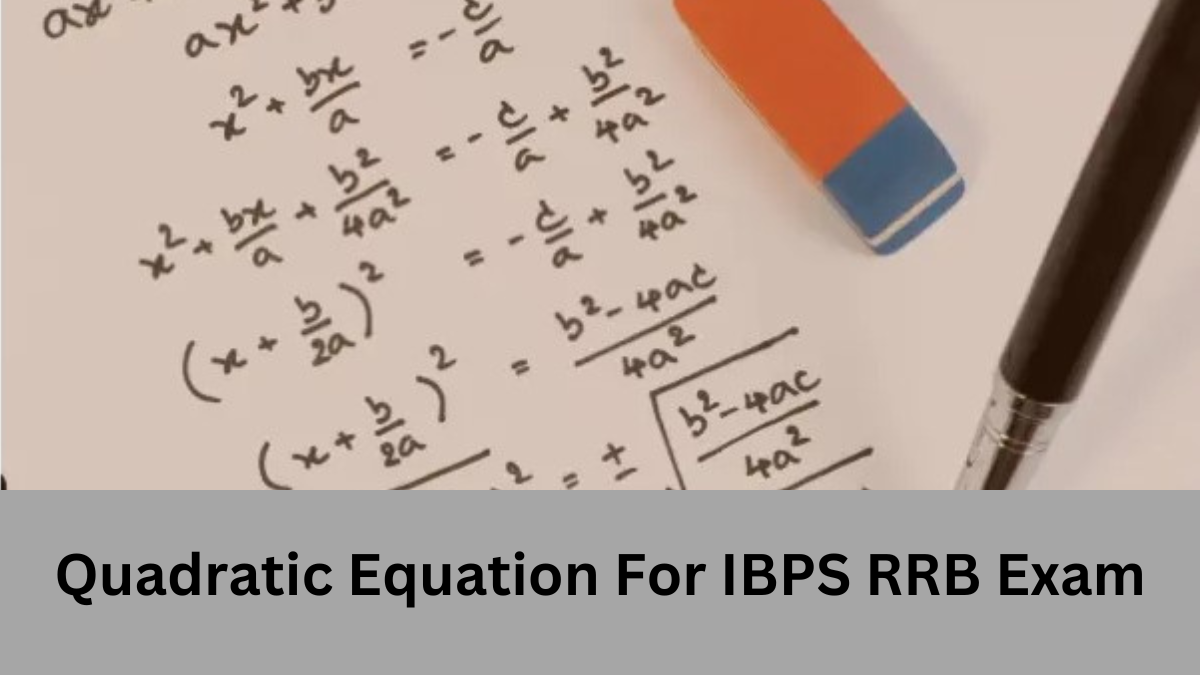Table of Contents
Quadratic equation is one of the most important and potentially high-scoring topics asked in the IBPS RRB exam and also in different banking exams, such as IBPS PO, SBI PO, SBI Clerk, IBPS Clerk, RRB Assistant, RRB Scale 1, etc. You can expect a set of 5 questions on this topic in the prelims of every banking and insurance examination. Achieving proficiency in this topic demands keen observational skills. Nonetheless, with dedicated practice, you can attain mastery and achieve a perfect score in this area. Here, we offer a diverse range of Quadratic Equation questions with solutions to facilitate effective practice and enhance your prospects of achieving a high score.
What is a Quadratic Equation?
A quadratic equation is a second-degree polynomial equation in one variable of the form:
ax² + bx + c = 0
where a, b and c are constants, and the x is variable. The x represents the unknown quantity, and the constants a, b and c determine the shape and nature of the equation.
Understanding the Quadratic Equation Formula
The quadratic formula is a formula that provides the two solutions to a quadratic equation. The Quadratic formula stands as the most straightforward method for determining the roots of a quadratic equation. In cases where certain quadratic equations resist easy factorization, the Quadratic formula offers a convenient and efficient means to swiftly calculate the roots.
The Quadratic Equation Formula
x = [-b±√(b2 – 4ac)]/2a
The Quadratic Formula is a rule that says that, in any equation of the form ax2 + bx + c = 0, the solution x-values of the equation are given by:
Solve using Quadratic formula 2x2 – 7x + 3 = 0
Solution:
Comparing the equation with the general form ax2 + bx + c = 0 gives,
a = 2, b = -7, and c = 3
Now, calculate the discriminant (b2 – 4ac):
b2 – 4ac = (-7)2 – 4 * 2 * 3 = 49 – 24 = 25
Now, substitute the values into the quadratic formula:
x1 = (-b + √(b2 – 4ac)) / (2a)
x1 = (-(-7) + √25) / (2 * 2)
x1 = (7 + 5) / 4 = 3
x2 = (-b – √(b2 – 4ac)) / (2a)
x2 = (-(-7) – √25) / (2 * 2)
x2 = (7 – 5) / 4 = 1/2
So, the roots of the equation 2x2– 7x + 3 = 0 are x1 = 3 and x2 = 1/2.
Factoring Quadratic Equations
Factoring quadratics is a technique used to represent the quadratic equation ax^2 + bx + c = 0 as a multiplication of its linear factors in the form (x – p) (x – q), where p and q represent the roots of the quadratic equation ax^2 + bx + c = 0.
Key Strategies for Quadratic Equation in RRB Exam
- Attentiveness: Be attentive and careful while solving the series especially because many candidates get perplexed while choosing the correct answer.
- Practice Regularly: Regular practice helps in quickly recognizing the common pattern
- For equations that cannot be solved by factorization, apply the quadratic formula or the method of completing the square.
- In word problems, carefully read the problem statement and identify the relevant variables and equations.
- Practice extensively with a variety of quadratic equation problems from previous years’ bank exam question papers and mock tests.
Quadratic Equations asked in IBPS RRB exams
Directions (1-10): In each of these questions, two equations (i) and (ii) are given. You have to solve both equations and give an answer.
A) x > y
B) x < y
C) x = y or the relationship cannot be established
D) x ≥ y
E) x ≤ y
Question 1:
I. 3x2 – 24x + 36 = 0
II. 4y2 = y + 5
Question 2:
I. x2 – 2x – 63 = 0
II. y2 + 14y + 48 = 0
Question 3:
I. x2 + 15x + 54 = 0
II. y2 + 20y + 99 = 0
Question 4:
I. 3x + 7y = 53
II. 7x – 5y = 17
Question 5:
I. x2 – 27x + 180 = 0
II. y2 – 24y + 140 = 0
Question 6:
I. x2 – 11x + 30 = 0
II. y2 – 11y + 18 = 0
Question 7:
I. x2 + 3x – 10 = 0
II. y2 – 5y + 6 = 0
Question 8:
I. x2 – 5x + 4 = 0
II. y2 + 2y – 3 = 0
Question 9:
I. 3x + 5y = 21
II. 9x – 2y = 12
Question 10:
I. 4x2 + 16x – 20 = 0
II. 2y2 + 11y – 6 = 0
Directions (11-20): In each of these questions, two equations (i) and (ii) are given. You have to solve both the equations and give answer
(a) If 𝑥 < 𝑦
(b) If 𝑥 > 𝑦
(c) If 𝑥 ≥ 𝑦
(d) If 𝑥 ≤ 𝑦
(e) If 𝑥 = 𝑦 or no relation can be established
Question 11.
I. 2x² – 17x + 36 = 0
II. 3y² – 22y + 40 = 0
Question 12.
I. x² + 21x + 108 = 0
II. y² + 14y + 48 = 0
Question 13.
I. 2x² + 7x – 60 = 0
II. 3y² – 28y + 64 = 0
Question 14.
I. x² – 2x – 24 = 0
II. y² + 3y – 40 = 0
Question 15.
I. 𝑥3 = 729
II. 𝑦2 − 15𝑦 + 54 = 0.
Question 16.
I. x2 + 13x – 114 = 0
II. y3 = 216
Question 17.
I. x2 − 6𝑥 + 12 = 4
II. y2 + 4𝑦 − 10 = −13
Question 18.
I. 12×2 − 7𝑥 + 1 = 0
II. 20y2− 9𝑦 + 1 = 0
Question 19.
I. x2 + 26𝑥 + 165 = 0
II. y2+ 23𝑦 + 132 = 0
Question 20.
I. x2 + 𝑥 − 6 = 0
II. 15y2− 11𝑦 + 2 = 0
Solutions:
| Quadratic Equation For IBPS RRB Exam: Solutions | |
| 1. A | 11. C |
| 2. C | 12. A |
| 3. D | 13. D |
| 4 .A | 14. E |
| 5. C | 15. C |
| 6. C | 16. D |
| 7. E | 17. A |
| 8. D | 18. B |
| 9. B | 19. E |
| 10.C | 20. E |




 GA Capsule for SBI Clerk Mains 2025, Dow...
GA Capsule for SBI Clerk Mains 2025, Dow...
 The Hindu Review October 2022: Download ...
The Hindu Review October 2022: Download ...
 World Malaria Day 2025
World Malaria Day 2025



